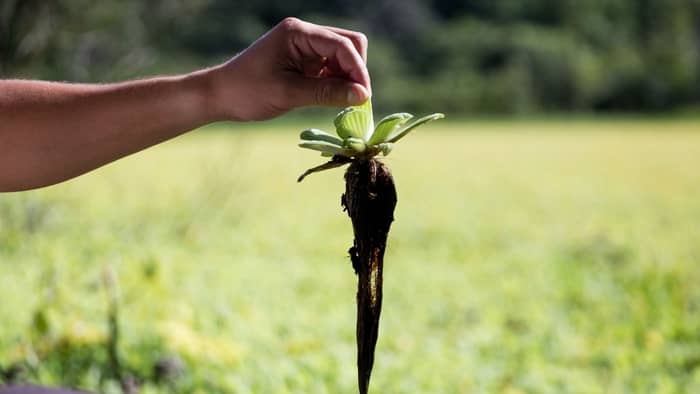Last Updated on January 25, 2022 by Marco C.
Have you ever heard of Deep Water Culture (DWC) hydroponics? We have put together the perfect guide to the best deep water culture system designs this year.
The key characteristic of any hydroponics setup is that it grows plants without using soil. In most gardens, the soil is what provides plants with nutrients and moisture to grow. In hydroponics, plant roots sit directly in a nutrient-rich water solution.
These plants are usually supported by a PVC pipe with holes drilled into it.
Most people like to grow fast-growing, shallow-rooted vegetables in a hydroponics system. Some popular plants grown are Italian basil, lettuce, arugula, and kale.
These plants have some kind of simple medium to support them upright. According to the Oklahoma State University, “Commonly used mediums include expanded clay, coir, perlite, vermiculite, brick shards, polystyrene packing peanuts, and wood fiber.”
What makes deep water culture system designs unique from traditional aquaponics is that it pumps extra oxygen into the water. The extra oxygen helps optimize the rate at which plants can take in nutrients.
Plants using deep water culture system designs are said to grow faster and stronger. How does the extra oxygen get into the water? A simple tool called an air pump and air stone.
Learn more about: What Can You Grow In Aquaponics Garden?
Do you want to grow fast, strong and healthy plants? Keep reading now to read about the best deep water culture systems design out this year!
What Exactly Is Deep Water Culture?
As mentioned before, Deep water culture is a form of hydroponics in which extra oxygen is pumped into the growing water. In order to do this, you have to have your air pump on for 24 hours a day. So be aware that this type of hydroponics uses a high amount of electricity.
We always suggest using a sustainable source of energy like solar or wind when possible. Unfortunately, the energy created from fossil fuels has actively hurt our planet over the past 100 years.
In order to use the air pump, you have to make sure that it is fully submerged in the water. At the end of your air pump, you can attach an air stone. Air stones basically disperse the water into a lot of tiny bubbles.
You can easily purchase air pumps and air stones from your local pet store. Usually, you will have to buy the piping and attach the air stones yourself. This will allow you to use pipes that specifically fit your tank.
As you may have guessed, another aspect of deep water culture is that your water reservoirs contain a large depth of water. Compared to traditional aquaponics, it is much deeper. The high water depth allows roots to grow longer.
The longer the roots, the larger the plant. Another benefit of a larger water reservoir is that the ecosystem is more easily stabilized. This means you do not have to clean or add nutrients as often.
In fact, deep water culture is considered to be one of the lowest maintenance hydroponics designs that you can do. Once you set it up, there is very little you have to do. Of course, this is if you do it all correctly.
Whenever working with deep water culture system designs, you have to pay attention to details. Only add your plants once you feel confident that all aspects of your system are working well.
Recirculating Deep Water Culture Diagram
If you have a chance to look at a recirculating deep water culture diagram you can see that it has a few main parts.
The first part is the water reservoir. The size of your water reservoir will determine the number of plants you can grow. Keep in mind, if you want to grow a lot of plants you need a very big reservoir. Another option is to have multiple, smaller reservoirs.
If you are doing it on a small scale, some people use a simple 15-20 gallon tank as their water container. However, in this case, you can only grow a few plants per tank.
At the top of the tank, there need to be some holes for your growing pods to sit in. As mentioned before, there is a range of materials you can use for your pots. These basically support the plants from falling into the water.
Lastly in the diagram, you will see the air pump and air stone set up. This usually enters through the top of the tank and sits at the bottom of your water.
You have the option of adding in a filtration and pump system. But it is not necessary. If you do not use a pump and filter then you will need to clean the water every so often.
As you can see it’s a very simple diagram and setup.
Negatives Of DWC Hydroponics
While there are many benefits of deep water culture system designs, there are also some negatives.
If you have a very small-scale system, it is easy for the water to get oversaturated with nutrients. When plants receive too much nutrients, they can die. Since you are working with only a small amount of water, any excess can greatly alter the chemical composition of the water.
Be sure to carefully measure out your nutrients before adding them to your plants.
Aside from that, deep water culture hydroponics is a great choice. Just take care to set up the system right and you will have thriving plants in no time!
Be creative with your design. You do not need to use an actual fish tank as your water reservoir. You can use anything that holds water like a bucket or a tub. Feel free to upcycle materials for this purpose.
If you haven’t experimented with deep water culture system designs, it is a great time to start! Give it a try and see how it compares to a normal hydroponics setup. Overall, it is easier, less maintenance, and yields a greater product.
Try it and let us know about your experience. Feel free to comment and ask questions below.
What exactly is deep water culture?
Deep water culture is a form of hydroponics in which extra oxygen is pumped into the growing water.

Candace is an aquaponics expert with over 5 years of experience in the field. She has a degree in environmental science from the University of California, Berkeley and a degree in aquaponics from the University of Florida. She is passionate about sustainable agriculture and has a deep knowledge of aquaculture and hydroponics. She has worked on numerous projects and has been involved in the development of aquaponic systems and fish farms. She also has experience in designing and constructing aquaponic systems. With her expertise, Candace is able to advise clients on the most effective and efficient way to construct and manage their aquaponic system. She is an active member of the aquaponic community, often speaking at conferences and seminars. Candace is dedicated to helping others understand the importance of aquaponics, and she is a strong advocate for sustainable food production.

